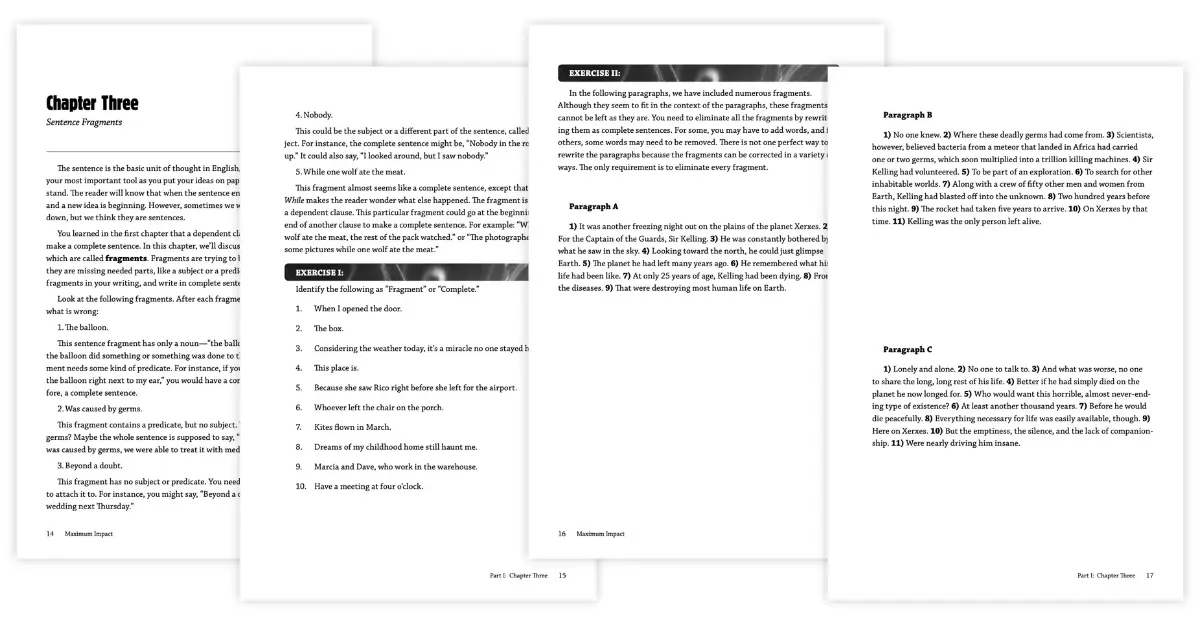It’s a no-brainer that students need to know the basics of grammar in order to function in the ELA classroom. And in an ideal world, students would remember the foundational rules—and effectively apply them—as soon as they’re taught them.
But we all know that’s not the case. Too often, we see students making the same grammatical mistakes in their writing. We can chalk that up to a lot of factors: using text-to-speech to write, relying on grammar software to catch mistakes, prompting AI programs to draft things on their behalf, or simply forgetting the rules due to learning loss.
Given these challenges, we need to tackle students' grammar woes head-on and offer instructional support to help them brush up on those grammar basics.
How Relearning Grammar Rules Helps
Relearning basic grammar and writing skills is like giving students a key to unlock a door they thought was closed. By revisiting the fundamentals, students not only reinforce what they already know but also fill in any gaps that might have popped up. It's about setting them up for success and helping them regain their footing in the world of language and communication:
Reinforce writing skills: Whether it’s crafting essays, analyzing literature, or expressing ideas in a persuasive way, students need to know how to use words and language effectively. By taking another look at grammar basics, students can write higher quality work, a valuable skill in the ELA classroom and beyond.
Improve reading comprehension: Understanding grammar isn’t just about putting together sentences; it’s also about deciphering meaning. When students know the basic mechanics of language, they’ll have an easier time approaching texts, even those that seem intimidating at first.
Build confidence: For students who may have fallen behind, mastering the fundamentals can give a much-needed confidence boost. With stronger skills, students are more self-assured in expressing their written thoughts and ideas.
Where to Start?
Structured instruction is key to helping students relearn the rules of grammar and writing. By breaking down complex concepts into manageable chunks, you can ensure that students aren’t overwhelmed and can tackle the material more easily.
For example, when teaching grammar, start with the basic building blocks such as parts of speech (nouns, verbs, adjectives, etc.) before getting into more advanced topics like clauses and phrases. By taking a step-by-step approach, students can gradually build back their knowledge without feeling lost or discouraged. Similarly, when teaching writing techniques, provide clear explanations and examples to illustrate each concept.
Practice is crucial. After introducing a new grammar rule or writing technique, provide students with exercises, activities, or writing prompts that allow them to apply what they've learned. Hands-on practice not only helps solidify their understanding, but also gives students the chance to refine their skills through repetition.
But what if you don’t have time to sit down and write tailored lessons on the most important parts of grammar? Leave that to Maximum Impact by Prestwick House! Through step-by-step instructions, pointed examples, and meaningful exercises, this workbook reinforces the logical application of grammar while giving students plenty of opportunities to improve their writing.

Perfecting Student Writing With Maximum Impact
Maximum Impact is divided into five parts that focus on specific grammar topics. The chapters in each part give an overview of the concept, showing students exactly how to put it into practice using several examples. As they work through the book, your students will explore grammar concepts such as:
Sentence Structure: Understanding the parts of a sentence (subject, predicate, clauses) and how they work together.
Sentence Fragments and Run-Ons: Identifying and correcting incomplete sentences (fragments) and overly long sentences lacking proper punctuation (run-ons) to improve coherence and readability.
Modifiers: Recognizing and correcting modifiers that are improperly positioned or don't clearly modify the intended word or phrase in a sentence.
Verb Tenses: Recognizing and using different verb tenses (past, present, future) accurately in writing.
Punctuation: Mastering the use of commas, semicolons, colons, and other punctuation marks to clarify meaning and enhance readability.
Subject-Verb Agreement: Ensuring that subjects and verbs agree in number and person.
Commonly Confused Words: Knowing the differences between your and you’re, affect and effect, lose and loose, and other tricky word pairings.
Active vs. Passive Voice: Understanding when to use active voice for clarity and directness versus passive voice for emphasis or specific stylistic purposes.
Each chapter includes plenty of writing exercises to reinforce understanding, including choosing the correct punctuation, identifying sentence parts, rewriting sentences for clarity, and more. Many of the exercises offer more than one way for students to answer, showing them the versatile nature of writing.
While students will have the best experience completing the entire book, Maximum Impact doesn’t have to be taught linearly. You can choose which sections to tackle based on your students’ individual needs. Although it’s intended for grades 6-9, Maximum Impact is perfect for remedial grammar and writing instruction at any high school level.

See Maximum Impact in Action
Through step-by-step instructions, pointed examples, and meaningful exercises, this workbook reinforces the logical application of grammar, punctuation, and usage rules while giving students ample opportunities to improve their writing.